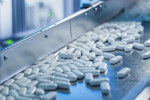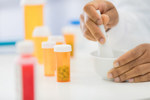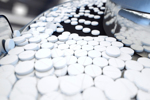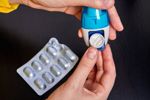Roller Compactor And Dry Granulation
ROLLER COMPACTORS AND DRY GRANULATION: SOLUTIONS, PRODUCTS, WHITE PAPERS, AND ARTICLES
-
Basic Principles Of Dry Granulation And Roller Compaction Technology
Granulation is a process in which powder particles are made to adhere to each other, resulting in larger, multiparticle entities, so called granules. If such a process is performed without adding liquids, this is called dry granulation. By Gerteis Maschinen + Processengineering AG
-
Tablet Manufacturing Technologies For Solid Drug Formulation
Compressed tablets are common oral solid dosages that contain the API and various excipients. Learn about the critical steps in selecting manufacturing methods and excipients to achieve the desired therapeutic effects and stability.
-
Advantages Of Spray-Dried Mannitol In Roll Compaction
Pharmaceutical excipients like mannitol enhance formulation stability, flowability, and compressibility, which are crucial for robust tablets. Read how these properties improve patient compliance.
-
Intro To USP <1062> - What It Is And Why You Should Use It
Knowing how to use USP <1062> helps manufacturers manage the wide variety of factors that can exacerbate production costs, or result in no product at all.
-
Key To Formulation Development Is In The Details
Find out how to face the challenges in tablet manufacturing environments through supportive vendor partnerships.
-
Wet Milling Vs. Dry Milling In The Pharmaceutical Industry
Read about the considerations necessary for choosing between wet milling and dry milling for a specific active pharmaceutical ingredient.
-
Facility Design For OSD Continuous Manufacturing
Facility design for continuous manufacturing of oral solid dose (OSD) drugs differs significantly from design of facilities dedicated to batch processing. The primary differences reside within the facility layout, in terms of consolidation of unit operations, utility sizing, and limited manual process involvement, which minimizes the number of required personnel.
-
The Impact Of Powder Morphology On Pharmaceutical Excipient Performance
Gain insight into the processing behavior of two lactose excipients through multiple powder rheology measurements of milled and spray-dried lactose.
-
Advancing Drug Development Using In Silico Modeling
Learn how in silico modeling can improve the likelihood of clinical success and return on investment for investigational new drug development.
-
Oral Solid Dosage Formulation And Process Development: A Case Study
This case study involves a drug substance currently in the preclinical phase. Discussion includes API physical chemical characteristics, enabling technologies, formulation assessment, and more.
-
Is Pre-Compression Tablet Thickness A True Critical Operating Parameter?
As recently as Nov. 2023, the topic of how pre-compression tablet thickness is viewed raised its head once again in an FDA inspection at a generic pharmaceutical company in India. This control is available on all modern tablet presses, yet instructions for its use are vague. This article shares how to use this control correctly and to be better prepared for an agency inspection.
-
Die Bore Cracking: How To Achieve Reliable Tablet Production
Die bore cracking is a significant issue in tablet manufacturing, affecting the quality of the tablets and potentially damaging the tablet press. Explore how to analyze for and prevent this damage.
-
Formulating Spray Dried Dispersions Into Tablets
Discover valuable insights on transforming spray-dried dispersions into effective tablet formulations by exploring our interview with Dr. Ian Lafferty, Chief Technical Officer at Upperton.
-
Simultaneous Spray Drying For Large/Small Mol Combinations
Gain insights into a “simul-spray” process pioneering for combining small and large molecules into a single, atomized drug product for inhalation administration.
-
Is Excessive Pressure in The Feed Frame Causing You Problems?
Are you having content uniformity issues in oral solid dosage manufacturing? Your slide gates and valves might not be in the best position with relationship to the powder feeder.
-
Amorphous Formulations For Insoluble Drugs: Rational Design & Practical Approaches On Formulation Screening & Development
The issues associated with amorphous formulations include solid state stability, chemical stability, reproducibility of API manufacturing, impurity of API, in vitro in vivo performance, process and scale-up.
-
Spray Drying To Enable New Inhaled Drug Products
The formulation and spray drying process can help manufacture a stable, highly respirable powder and deliver products that require a high drug load, a biologic, or rapid onset therapeutic.
-
It All Starts With An Idea…Unlocking Pharmaceutical Success
Every capsule and tablet begins with an idea. It takes a professional and innovative manufacturing partner to turn that idea into a reality. Enter Natoli, a name synonymous with excellence in pharmaceutical equipment and services. From the early stages of formulation to the grand scale of full-blown production, Natoli offers a seamless journey through every step of the process. Whether you’re unsure of how to start or how to finish, Natoli can guide the way.
-
Rheological Properties Of Pharmaceutical Excipients: Lactose Monohydrate And Carboxymethyl Cellulose
Explore lactose monohydrate and CMC rheology, highlighting their flow, cohesion, and compressibility properties to optimize pharmaceutical formulations under varying stress and temperature conditions.
-
Understanding Of Amorphous Solid Dispersions & Their Downstream Development
Understanding the properties of ASDs and their relationship to the downstream product scale up, stability, and in-vivo performance is critical to successfully utilize them for drug delivery of insoluble drugs.
ABOUT TABLET COMPRESSION AND TABLET COOLING
Most pills we take these days are molded tablets because the have the advantage of disintegrating quickly when exposed to moisture. These molded tablets are actually compressed powder mixtures.
Tablet formulations are generally designed and tested using a tablet compaction simulator. This is computer-controlled device that can measure the punch positions, punch pressures, friction forces, die wall pressures and even the internal temperature of the tablet while it is being compressed.
These simulators only require a very small quantity of a mixture so multiple experiments can be run without wasting too much of the active ingredients in the product to find the optimal formulation of the drug.
Tablet presses or tableting machines come in a variety of models from inexpensive table top models that make one pill at a time to large, computerized industrial models that produce millions of tablets per using very high pressures. Tablet presses are essential for pharmaceutical anunutraceutical manufacturers.
Many, if not most tablets today are coated prior to being pressed. Coatings are made of polymer and polysaccharide. Coatings also help create a smooth surface and tablet finish so they are easier to swallow. The coating masks unpleasant odors and allows the manufacturer to stamp on an indentifying mark on the tablet which is often required by regulatory agencies.
When the coating applied, the drying of the coating takes place by drawing heated air through the tablet bed from a fan. The temperature, humidity, dew point, air circulation and air pressure must be monitored for the given space to make certain the coating does not peel, crack or become pitted, contaminated, twinned, or discolored. This process of cooling is necessary to produce consistency in the coatings from pill to pill.


















